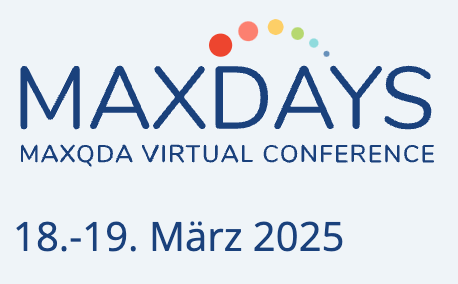How I used MAXQDA to write a literature review for my thesis project in the field of Educational Sciences and Health Education.
Abstract
In this article, I will explain how I used MAXQDA to write a literature review for my thesis project. Before using MAXQDA, I had already begun searching for scientific articles in databases related to my research field (CINHAL, PubMed, ERIC, etc.) and collected a few relevant articles to initiate my literature review. I used the bibliographic referencing software EndNote to manage my references. When there was a RIS file available, I imported it directly into EndNote and attached the PDF of the article, which allowed me to later insert my references while writing my text (e.g., in a Word Document). As I accumulated more and more articles, I attempted to grasp the concepts, methods, and make connections between them. Quickly, I realized that I was losing a lot of information that could be useful for the writing of my thesis proposal. Therefore, I decided to use MAXQDA software to write my literature review. I had previously used MAXQDA for qualitative analysis, but this was the first time I chose to us it to analyse articles. In this post, I will share my discoveries and the features I used to complete this work.
Writing a literature review: combining parts into a whole – constructing a meaningful corpus of articles
MAXQDA allows to import various types of data (Image, Audio, Video, PDF, etc.) and to analyse them easily. Most scientific articles are now available in PDF format and that was the case of most of the articles I worked with. Therefore, I could import PDF Documents directly into MAXQDA. MAXQDA also allows importing bibliographic data from the Reference Manager Data, which subsequently provides the opportunity to conduct Crosstab in the mixed methods functions of your articles based on their Variables.
I decided to import my articles directly in PDF format, using the same naming format consistently. Since I was previously importing my articles into EndNote, I used a function in EndNote that allowed me to rename articles in the following format: name-date-title. After renaming it, I exported the PDF document and imported it into MAXQDA. During this process, I discovered the possibility of creating an automatic import folder (Preferences: Automatic import). This folder proved to be very useful. Once this folder was created, all the documents I placed in it were automatically imported into MAXQDA. This allowed me to save a considerable amount of time, as I would simply deposit new articles into this folder, which were then automatically imported into my MAXQDA project.
When integrating my materials (primarily scientific articles), I systematically thought about the role of each article in my work. Was it an article to be used in my literature review or in the methodology section? What place did this article have within my corpus (importance, quality, etc.)? To organize my articles based on these criteria, I created document groups and document sets in the Document system. I used Document groups to organize articles according to their role (Literature, Methodology) and document sets to sort them according to more specific criteria (e.g., discipline, qualitative or quantitative study, etc.) and related to content (e.g., patient engagement, experiential knowledge, etc.).
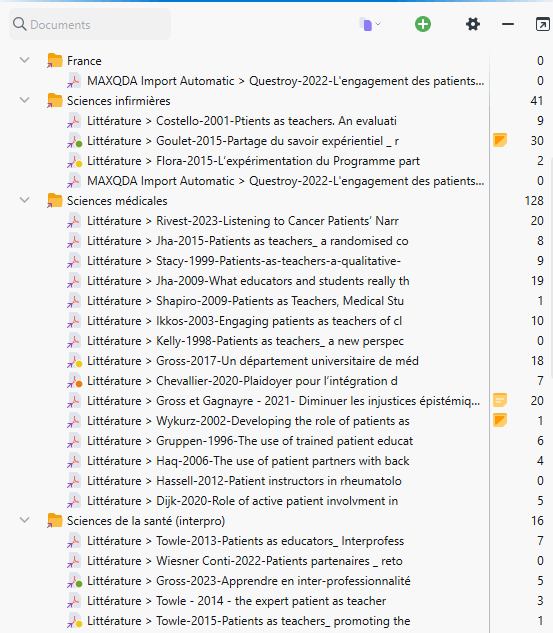
Capture of the Document Sets in the Document system
In summary: In this paragraph, I explained how I integrated the materials I was interested in (articles, grey literature) into MAXQDA. This analytical activity required considering the type of material to collect, its role, and the relationships between this material and my objectives.
Writing a literature review: organizing documents – how to create a structure into MAXQDA to meet research objectives?
I quickly accumulated many articles, and it was necessary to think about how to organize them to meet my objectives which consisted in familiarisation with the field of research, identification of research gaps, problematisation, and formulation of research questions. So, I wondered how to structure this data. I decided to capture the inherent structure of my articles using New Codes to create what could be seen as traditional reading cards of articles (abstract, objective, method, results, discussion, conclusion). I added a code for concepts and theories used in the articles. These codes allowed me to quickly explore my corpus of articles (e.g., by reading abstracts) and select those I wanted to prioritize for further reading and coding.
I also used a second method to organize my articles by using Document Sets. It is possible to add an article to multiple sets, which is particularly useful when you want to organize articles based on multiple criteria (e.g., by methodology, content, discipline). Specifically, I created document sets for the different disciplines that contributed to my research field (nursing, medical sciences, etc.), the different methodologies used (qualitative, quantitative, mixed methods, literature review), and the main themes of interest (patient engagement, experiential knowledge, etc.). In this way, when I wanted to explore a specific theme or articles from a specific discipline, I could activate the corresponding document set. This work was important because it allowed for comparison (similarities, differences) between articles in my corpus and a better understanding of it. This was an essential step in becoming familiar with this new research field.
I found that the organization of research data could be supported by MAXQDA’s search functions. I mainly used Lexical Search & Autocode to quickly explore my articles (e.g., by searching for a keyword to organize my articles into sets) and to support coding. For example, I searched for a concept of interest, reviewed the selected segments, and then coded those relevant to the definition of that concept. For more efficiency, I also used the exclusion list in the lexical search results window and then Autocode Search Results with a new or existing code. I also used the Logbook in the main menu and Memos to keep track of my ideas, questions, opinions, and the progress of my work. Finally, colours were useful to mark articles I had already read (e.g., in green) and the articles I wanted to read (e.g., in orange).
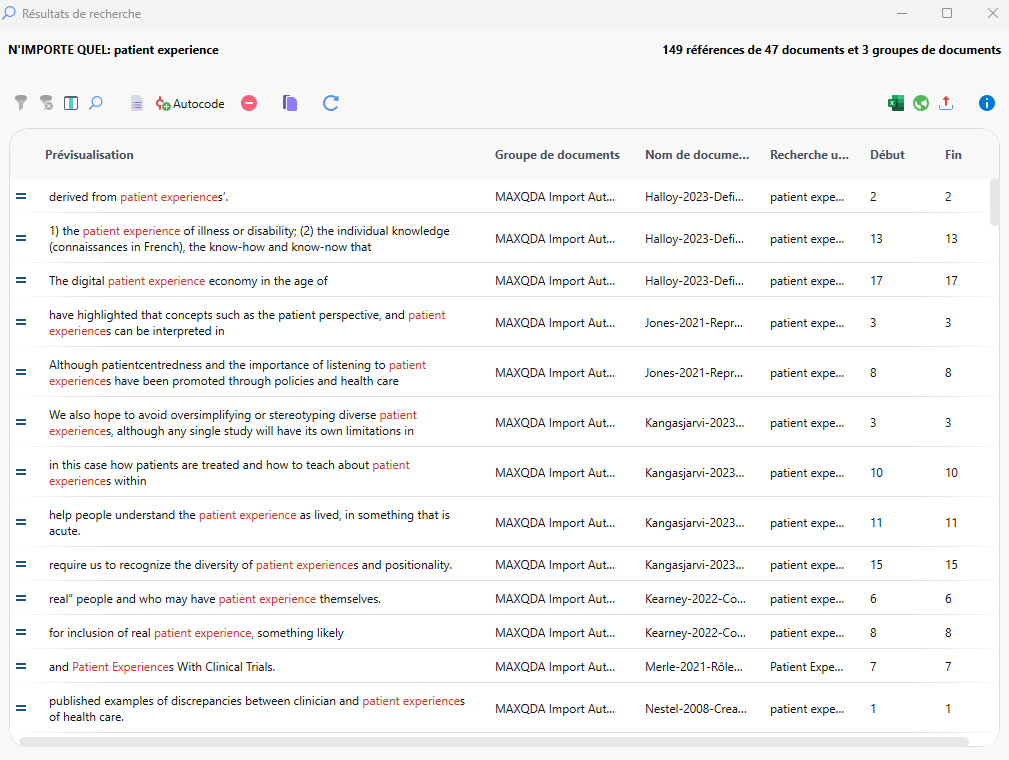
Capture of the results window of the Lexical Search of “patient experience”
In summary: In this paragraph, I explained how I organized my documents based on criteria that met my objectives. I needed to define criteria that allowed me to compare articles in my corpus. So, I organized my articles based on various criteria: methodology, discipline, theme, etc. This analytical activity involved reflective work on my part as I asked myself: What is relevant to my field of research? What interests me? etc. These reflexions were documented in Memos and the Logbook, for example.
Writing a literature review: exploring data’s structure and content – what is the nature of my articles?
Exploration is an essential analytical activity in qualitative research. MAXQDA greatly facilitates this exploration with search tools and activation (documents, codes). It is also possible to use metadata (Document Variables) to conduct searches in our data.
I examined the nature of my data in terms of content and structure. To explore content, I used lexical search and looked for concepts or words of interest. I also examined the most frequent words in certain documents (Word Trends), which gave me an idea of the key concepts and ideas in that text. This could provide insights into the content of the data and therefore the codes to create.
Since I had coded my articles based on their internal structure (abstract, method, results, discussion, conclusion), I could also use this structure to explore my corpus.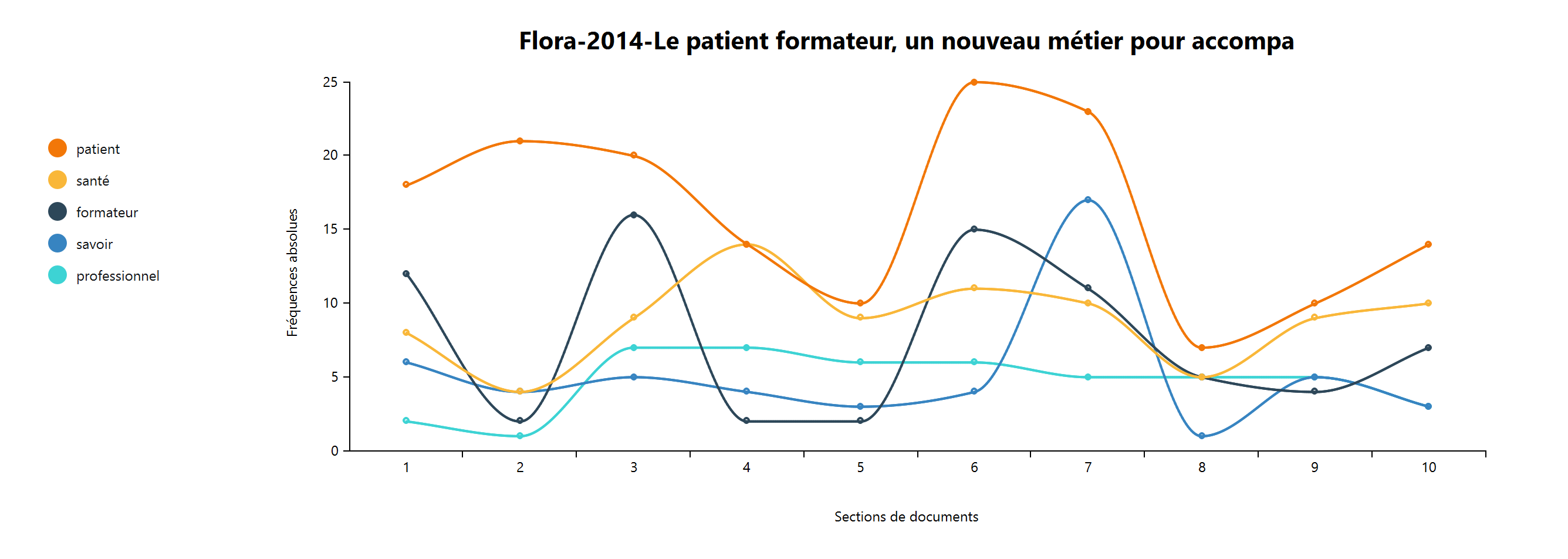
Capture of the Word Trend based on the article of Flora (2014)
In summary:In this paragraph, I explained how MAXQDA helped me explore my data in terms of content and structure using the following features: activation (documents, codes), word trends, and lexical search.
Writing a literature review: reflecting carefully and in depth
There are many reflective activities in qualitative research (summarizing, questioning, condensing, etc.) that MAXQDA can support. As I mentioned before, Memos and the Logbook helped me keep track of my ideas, questions, etc. I also used the Summary Grid to condense the information from my coded segments. This grid is very practical because it allows access to coded segments and summarizing them. Once this work was done, I could easily access all my summaries in the Summary Explorer. I find that this explorer facilitated synthesis and writing. Reflection can also be supported by visualization tools that allow for connections between authors and concepts. For example, I used MAXMaps to create a map of coded segments related to a concept using the Single-Code-Model. To create this map, I activated the documents and the code of interest, and then chose the single-case model.
When considering our data carefully and in depth, we can identify topics that are well-covered in the literature and those that are less so. This can guide us in searching for additional articles to meet our needs. To gain an overview of the coverage of themes in my corpus, I used the Code Matrix Browser. I did not use Group & Case Comparison, but I plan to do it next time.
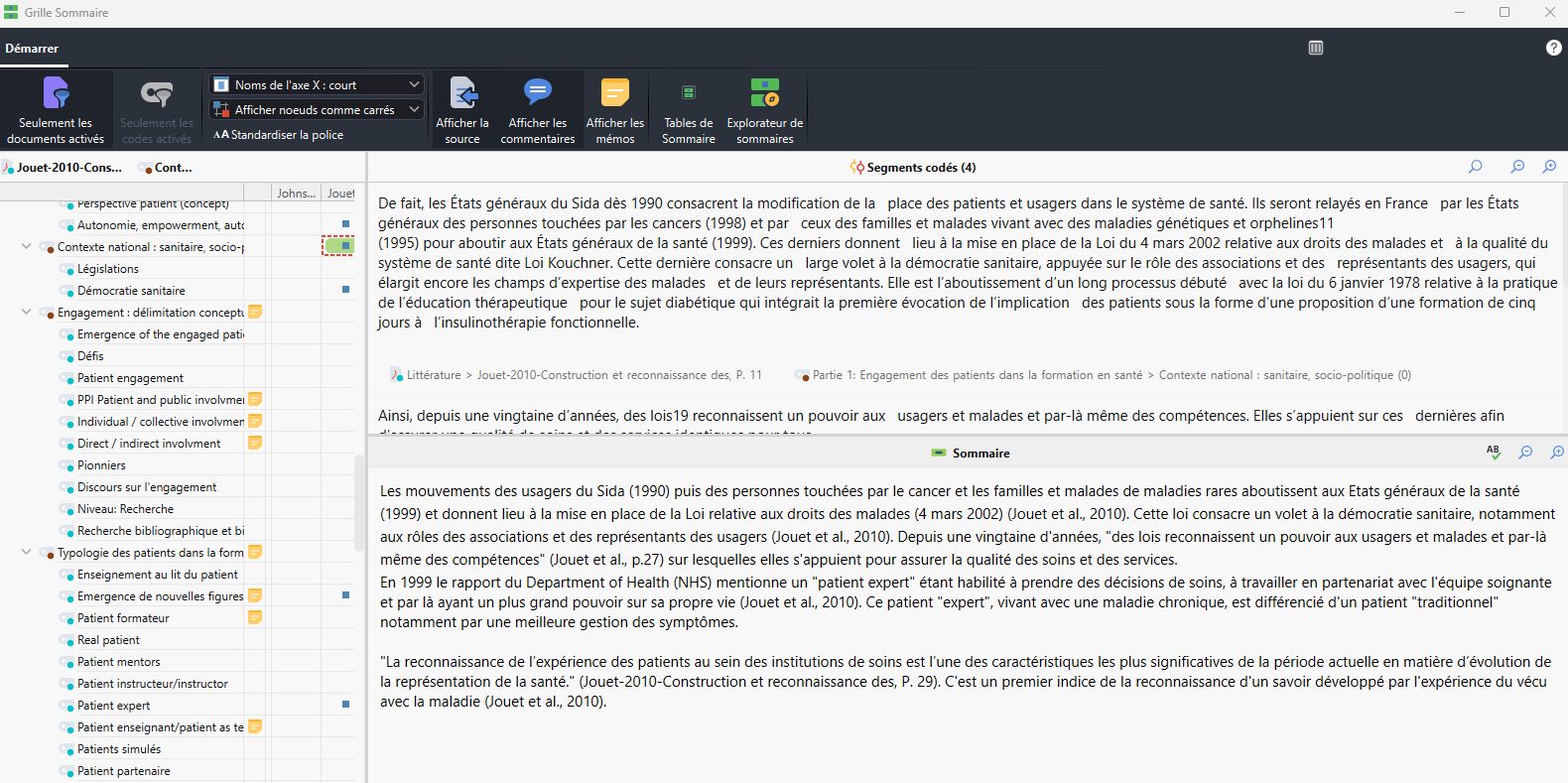
Capture of the Summary Grid for summarizing coded segments
In summary: In this paragraph, I explained how MAXQDA helped me to consider my data carefully and in depth. I particularly used Memos and the Logbook to note my reflections. I used the summary grid to summarize my coded segments. I also used visualization to map connections between Documents and Codes (concepts). The code matrix allowed me to gain an overview of the main topics covered in my articles and those that were less covered.
Writing a literature review: interrogating – what do I know and what should I know?
CAQDAS tools are truly powerful for interrogating data, comparing, illustrating, etc. Activation is an easy-to-use tool that provides quick access to the information of interest. For example, when I was interested in challenges addressed in literature reviews, I could activate the “Challenges” code and the “literature review” document set. The coded segments then appeared in the Retrieved Segments Window. I could then reread them in this window. When I had created summaries of these segments, I could also work directly from these summaries using the summary explorer. When interrogating my data, I also took note of my questions and hypotheses.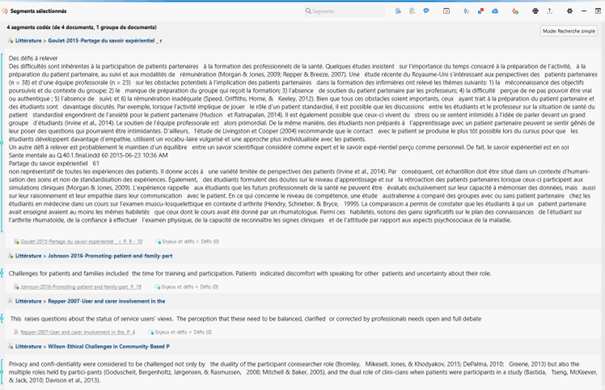
Capture of the Retrieval of coded segments: Documents set
“Literature review” and code “Challenges” are activated
I also discovered a feature that, in my opinion, facilitates the various analytical activities I mentioned before: the Question-Themes-Theories (QTT) Sheet. This sheet allowed me to integrate the results of my work (codes, coded segments, summaries, visualization, etc.) and formulate my ideas (hypotheses, theories, questions, interpretations, etc.).
In summary: In this paragraph, I explained how MAXQDA helped me to interrogate and compare my data (segments, summaries). I also suggested using the QTT Sheet to continue the work done so far and formulate interpretations and hypotheses based on the previous analytical activities.
Conclusion
In conclusion, I offered a list of functionalities that were useful to me during the literature review, and I am hoping this will be inspiring for you. For learning more about literature review with MAXQDA you can also check this available Guide written by Udo Kuckartz and Stefan Rädiker (2019).
About the Author
Félicia Bielser is a PhD candidate at the Psychology and Educational Sciences department at the University of Geneva, and a research assistant at the University of Applied Sciences and Arts Western, School of Health Sciences, Switzerland. Her thesis focuses on patient engagement in health education, and she is more specifically interested in investigating how patients, teachers and students mobilize patient’s experiential knowledge in their educational activities.

 Félicia Bielser is a PhD candidate at the Psychology and Educational Sciences department at the University of Geneva, and a research assistant at the University of Applied Sciences and Arts Western, School of Health Sciences, Switzerland. Her thesis focuses on patient engagement in health education, and she is more specifically interested in investigating how patients, teachers and students mobilize patient’s experiential knowledge in their educational activities.
Félicia Bielser is a PhD candidate at the Psychology and Educational Sciences department at the University of Geneva, and a research assistant at the University of Applied Sciences and Arts Western, School of Health Sciences, Switzerland. Her thesis focuses on patient engagement in health education, and she is more specifically interested in investigating how patients, teachers and students mobilize patient’s experiential knowledge in their educational activities.


